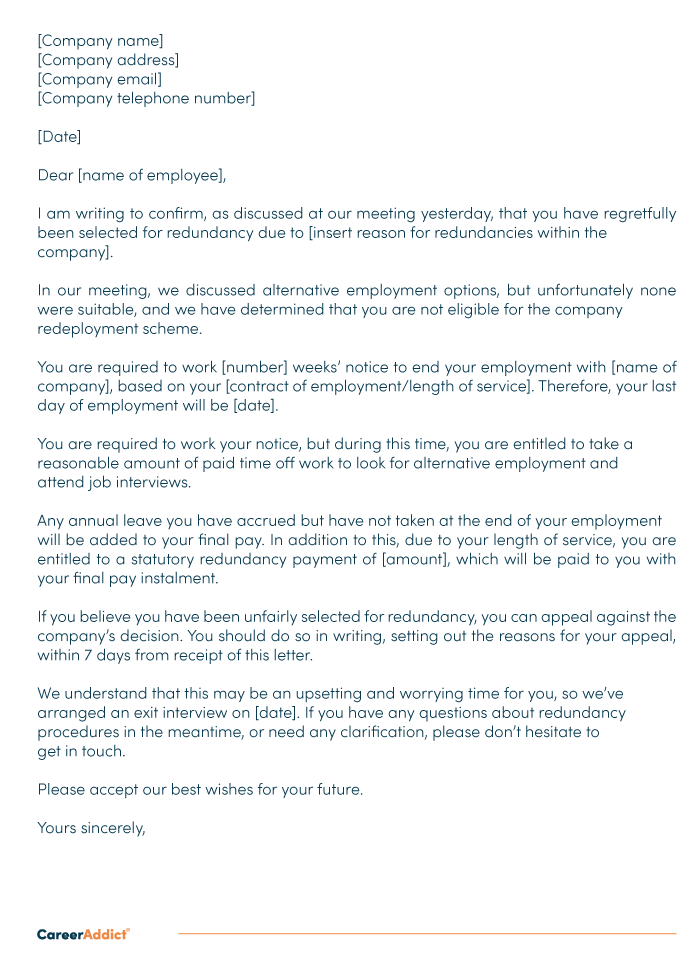Just How to Deal With Redundancy Pay If Company Goes Bust: Trick Information for UK Employees
Just How to Deal With Redundancy Pay If Company Goes Bust: Trick Information for UK Employees
Blog Article
Exploring the Interplay In Between Firm Redundancy and Organizational Flexibility for Future Development
In the dynamic landscape of today's organization world, the complex partnership between firm redundancy and organizational adaptability arises as an important element for sustained development and success. Firms often deal with the difficulty of striking a delicate equilibrium between preserving a level of redundancy to reduce threats and cultivating adaptability to react swiftly to the ever-evolving market demands.
Value of Firm Redundancy
Firm redundancy is a crucial aspect that boosts organizational resilience and minimizes operational risks. By integrating redundancy procedures within the business structure, companies can better endure unpredicted disturbances and changes in business environment. Redundancy acts as a critical barrier, enabling companies to adjust and react successfully to unexpected obstacles without jeopardizing vital procedures.
One trick element of the value of firm redundancy is its role in guaranteeing continuity during times of crisis. When encountered with abrupt adjustments or emergencies, redundant systems, resources, or personnel can action in to maintain vital functions and avoid prevalent disruptions. This connection not just safeguards the business's online reputation and client count on however likewise lessens financial losses and functional downtime.

Approaches for Organizational Versatility

An additional important strategy is purchasing innovation and framework that can support flexibility and scalability. Executing digital devices, automation, and information analytics can simplify procedures, boost efficiency, and give useful insights for notified decision-making. In addition, producing adaptable organizational structures that enable quick adjustments to market characteristics and consumer demands is essential for staying competitive in a rapidly developing atmosphere. By proactively recognizing prospective disturbances and chances, organizations can proactively flourish and adapt in an ever-changing company landscape.
Balancing Redundancy and Flexibility
Attaining an unified balance in between functional redundancy and business versatility is paramount in navigating the intricacies of a dynamic company atmosphere. Redundancy within a firm offers a safeguard, guaranteeing continuity and security in procedures. However, an unwanted of redundancy can result in inadequacies and hinder flexibility to altering market conditions. On the various other hand, organizational versatility enables companies to respond promptly to exterior disturbances and seize new opportunities. Striking the right equilibrium between redundancy and if a company goes bust who pays redundancy versatility is a fragile procedure that needs a deep understanding of the company's objectives, industry dynamics, and risk tolerance.
To attain this equilibrium, business require to perform normal assessments of their operations to determine locations where redundancy is required for threat mitigation and where versatility can drive technology and development. Executing flexible structures, fostering a culture of continual understanding and renovation, and motivating open communication across all levels of the company are key approaches to harmonize redundancy and flexibility properly. By aligning these 2 vital aspects, companies can place themselves for lasting growth and success in an ever-changing business landscape.
Case Research Studies on Adjustment Success
In analyzing instances of effective organizational adjustment, it ends up being noticeable that the interplay between operational redundancy and flexibility is a specifying element in shaping durable organizations. A DVD rental service, Netflix demonstrated exceptional versatility by transitioning right into a streaming system when digitalization interfered with the industry. These situation studies emphasize the importance of functional redundancy combined with organizational flexibility in fostering long-lasting growth and competitiveness.
Building Durability for Future Growth
Building strength for future growth calls for a strategic alignment of functional procedures with market dynamics and emerging trends. Firms need to adjust to altering environments by cultivating a society of flexibility, innovation, and continual improvement. Durability involves not only recuperating from problems but likewise proactively preparing for future obstacles. One crucial aspect of building durability is buying robust threat monitoring strategies to alleviate potential disturbances. This consists of scenario preparation, branching out supply chains, and developing backup prepare for numerous contingencies (who pays redundancy money).
Furthermore, fostering strong relationships with stakeholders, such as clients, employees, providers, and the community, is essential for preserving and weathering unpredictabilities trust fund and support throughout turbulent times. Effective communication and openness play a vital function in building resilience, as they help line up expectations and assist in partnership in browsing uncertainties.
Furthermore, companies require to prioritize knowing and advancement initiatives to upskill workers and furnish them with the necessary devices to adapt to altering situations. By buying their workforce, business can boost their flexibility and dexterity, eventually reinforcing their strength for lasting future development.
Conclusion

In the dynamic landscape of today's company globe, the detailed connection between business redundancy and organizational adaptability emerges as a crucial factor for continual growth and success. Companies commonly encounter the challenge of striking a delicate equilibrium in between keeping a degree of redundancy to minimize dangers and promoting adaptability to respond quickly to the ever-evolving market needs.To attain this balance, companies need to carry out regular evaluations of their operations to determine locations where redundancy is necessary for threat reduction and where flexibility can drive technology and development.In final thought, the interplay between company redundancy and organizational adaptability is vital for future growth. Structure durability through a combination of redundancy and versatility will certainly guarantee that firms are prepared for the challenges of the future.
Report this page